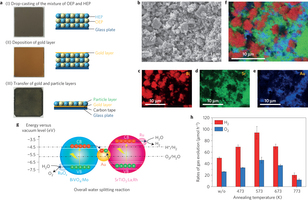|
xxxx
|
 XXXXXXXXXXXXXXXXXXXXXXXXXXXXXXXXXXXXXXXXXXXXXXXXXXXXXXXXXXXX XXXXXXXXXXXXXXXXXXXXXXXXXXXXXXXXXXXXXXXXXXXXXXXXXXXXXXXXXXXX
Scalable Water Spliting on Particulate Photocatalyst Sheets With a Solar-to-Hydrogen Energy Conversion Efficiency Exceeding 1%
BaC6
Alexandro Kirch
Tuesday, June 21, 2016
Photocatalytic water splitting using particulate semiconductors is a potentially scalable and economically feasible technology for converting solar energy into hydrogen. Z-scheme systems based on two-step photoexcitation of a hydrogen evolution photocatalyst (HEP) and an oxygen evolution photocatalyst (OEP) are suited to harvesting of sunlight because semiconductors with either water reduction or oxidation activity can be applied to the water splitting reaction. However, it is challenging to achieve efficient transfer of electrons between HEP and OEP particles. Here, we present photocatalyst sheets based on La- and Rh-codoped SrTiO3 (SrTiO3:La,Rh ) and Mo-doped BiVO4 (BiVO4:Mo) powders embedded into a gold (Au) layer. Enhancement of the electron relay by annealing and suppression of undesirable reactions through surface modification allow pure water (pH 6.8) splitting with a solar-to-hydrogen energy conversion efficiency of 1.1% and an apparent quantum yield of over 30% at 419 nm. The photocatalyst sheet design enables efficient and scalable water splitting using particulate semiconductors.
View full text
|